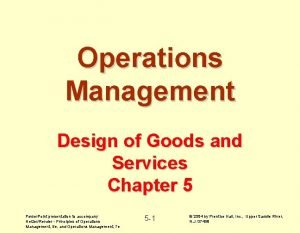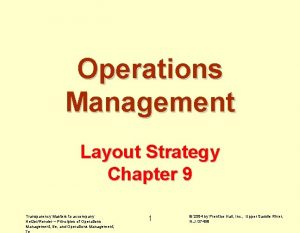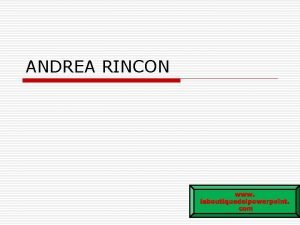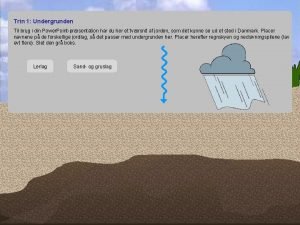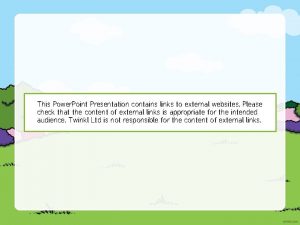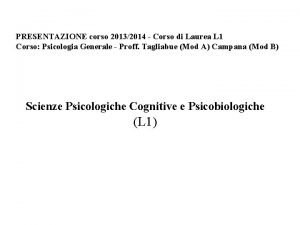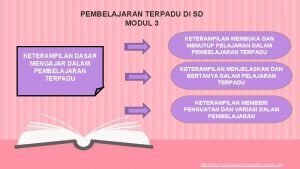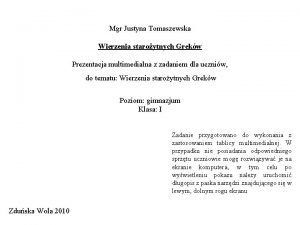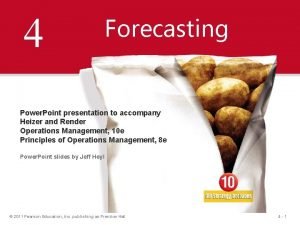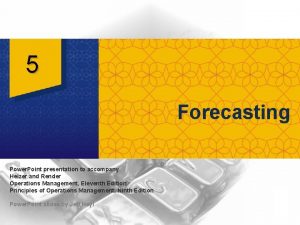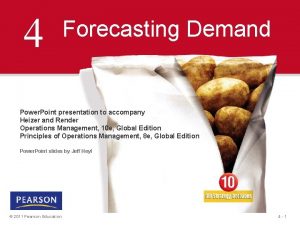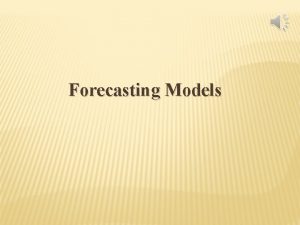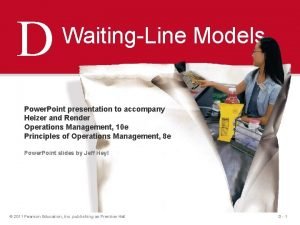4 Forecasting Power Point presentation to accompany Heizer



















































































![Correlation Coefficient n. Sxy - Sx. Sy r= [n. Sx 2 - (Sx)2][n. Sy Correlation Coefficient n. Sxy - Sx. Sy r= [n. Sx 2 - (Sx)2][n. Sy](https://slidetodoc.com/presentation_image_h2/9822824106fbb1ff63d7a79d8b294382/image-84.jpg)
![Correlation Coefficient y y n. Sxy - Sx. Sy r= 2 - (Sx)2][n. Sy Correlation Coefficient y y n. Sxy - Sx. Sy r= 2 - (Sx)2][n. Sy](https://slidetodoc.com/presentation_image_h2/9822824106fbb1ff63d7a79d8b294382/image-85.jpg)










- Slides: 95

4 Forecasting Power. Point presentation to accompany Heizer and Render Operations Management, 10 e Principles of Operations Management, 8 e Power. Point slides by Jeff Heyl © 2011 Pearson Education, Inc. publishing as Prentice Hall 4 -1

Outline u What Is Forecasting? u Forecasting Time Horizons u The Strategic Importance of Forecasting u Forecasting Approaches Qualitative Methods Quantitative Methods © 2011 Pearson Education, Inc. publishing as Prentice Hall 4 -2

Outline – Continued u Time-Series Forecasting u Decomposition of a Time Series u Naive Approach u Moving Averages u Exponential Smoothing with Trend Adjustment u Trend Projections u Seasonal Variations in Data u Cyclical Variations in Data © 2011 Pearson Education, Inc. publishing as Prentice Hall 4 -3

Outline – Continued u Associative Forecasting Methods: Regression and Correlation Analysis u Monitoring and Controlling Forecasts u Adaptive Smoothing u Focus Forecasting u Forecasting in the Service Sector © 2011 Pearson Education, Inc. publishing as Prentice Hall 4 -4

What is Forecasting? u Process of predicting a future event u Underlying basis of all business decisions ? ? u Production u Inventory u Personnel u Facilities © 2011 Pearson Education, Inc. publishing as Prentice Hall 4 -5

Forecasting Time Horizons u Short-range forecast u Up to 1 year, generally less than 3 months u Purchasing, job scheduling, workforce levels, job assignments, production levels u Medium-range forecast u 3 months to 3 years u Sales and production planning, budgeting u Long-range forecast u 3+ years u New product planning, facility location, research and development © 2011 Pearson Education, Inc. publishing as Prentice Hall 4 -6

Influence of Product Life Cycle Introduction – Growth – Maturity – Decline u Introduction and growth require longer forecasts than maturity and decline u As product passes through life cycle, forecasts are useful in projecting u Staffing levels u Inventory levels u Factory capacity © 2011 Pearson Education, Inc. publishing as Prentice Hall 4 -7

Product Life Cycle Company Strategy/Issues Introduction Growth Maturity Decline Best period to increase market share Practical to change price or quality image Poor time to change image, price, or quality R&D engineering is critical Strengthen niche Competitive costs become critical Defend market position Drive-through Internet search engines i. Pods Xbox 360 Sales Cost control critical restaurants CD-ROMs LCD & plasma TVs Avatars Boeing 787 Twitter Analog TVs Figure 2. 5 © 2011 Pearson Education, Inc. publishing as Prentice Hall 4 -8

Product Life Cycle OM Strategy/Issues Introduction Product design and development critical Frequent product and process design changes Short production runs High production costs Limited models Attention to quality Growth Forecasting critical Maturity Standardization Fewer product Product and changes, more process minor changes reliability Optimum Competitive capacity product Increasing improvements stability of and options process Increase capacity Long production runs Shift toward product focus Product improvement and Enhance cost cutting distribution Decline Little product differentiation Cost minimization Overcapacity in the industry Prune line to eliminate items not returning good margin Reduce capacity Figure 2. 5 © 2011 Pearson Education, Inc. publishing as Prentice Hall 4 -9

Strategic Importance of Forecasting u Human Resources – Hiring, training, laying off workers u Capacity – Capacity shortages can result in undependable delivery, loss of customers, loss of market share u Supply Chain Management – Good supplier relations and price advantages © 2011 Pearson Education, Inc. publishing as Prentice Hall 4 - 10

The Realities! u Forecasts are seldom perfect u Most techniques assume an underlying stability in the system u Product family and aggregated forecasts are more accurate than individual product forecasts © 2011 Pearson Education, Inc. publishing as Prentice Hall 4 - 11

Forecasting Approaches Qualitative Methods u Used when little data exist u New products u New technology u Involves intuition, experience u e. g. , forecasting sales on Internet © 2011 Pearson Education, Inc. publishing as Prentice Hall 4 - 12

Qualitative Methods 1. Jury of executive opinion (Pool opinions of high -level experts, sometimes augment by statistical models) 2. Delphi method (Panel of experts, queried iteratively until consensus is reached) 3. Sales force composite (Estimates from individual salespersons are reviewed for reasonableness, then aggregated) 4. Consumer Market Survey (Ask the customer) © 2011 Pearson Education, Inc. publishing as Prentice Hall 4 - 13

Quantitative Approaches u Used when situation is ‘stable’ and historical data exist u Existing products u Current technology u Involves mathematical techniques u e. g. , forecasting sales of LCD televisions © 2011 Pearson Education, Inc. publishing as Prentice Hall 4 - 14

Quantitative Approaches 1. Naive approach 2. Moving averages 3. Exponential smoothing time-series models 4. Trend projection 5. Linear regression © 2011 Pearson Education, Inc. publishing as Prentice Hall associative model 4 - 15

Time Series Forecasting u Set of evenly spaced numerical data u Obtained by observing response variable at regular time periods u Forecast based only on past values, no other variables important u Assumes that factors influencing past and present will continue influence in future © 2011 Pearson Education, Inc. publishing as Prentice Hall 4 - 16

Time Series Components Trend Cyclical Seasonal Random © 2011 Pearson Education, Inc. publishing as Prentice Hall 4 - 17

Components of Demand for product or service Trend component Seasonal peaks Actual demand line Average demand over 4 years Random variation | 1 | 2 | 3 Time (years) © 2011 Pearson Education, Inc. publishing as Prentice Hall | 4 Figure 4. 1 4 - 18

Trend Component u Persistent, overall upward or downward pattern u Changes due to population, technology, age, culture, etc. u Typically several years duration © 2011 Pearson Education, Inc. publishing as Prentice Hall 4 - 19

Seasonal Component u Regular pattern of up and down fluctuations u Due to weather, customs, etc. u Occurs within a single year Period Length Number of Seasons Week Month Year Day Week Day Quarter Month Week 7 4 -4. 5 28 -31 4 12 52 © 2011 Pearson Education, Inc. publishing as Prentice Hall 4 - 20

Cyclical Component u Repeating up and down movements u Affected by business cycle, political, and economic factors u Multiple years duration u Often causal or associative relationships 0 © 2011 Pearson Education, Inc. publishing as Prentice Hall 5 10 15 20 4 - 21

Random Component u Erratic, unsystematic, ‘residual’ fluctuations u Due to random variation or unforeseen events u Short duration and nonrepeating © 2011 Pearson Education, Inc. publishing as Prentice Hall M T W T F 4 - 22

Naive Approach u Assumes demand in next period is the same as demand in most recent period u e. g. , If January sales were 68, then February sales will be 68 u Sometimes cost effective and efficient u Can be good starting point © 2011 Pearson Education, Inc. publishing as Prentice Hall 4 - 23

Moving Average Method u MA is a series of arithmetic means u Used if little or no trend u Used often for smoothing u Provides overall impression of data over time ∑ demand in previous n periods Moving average = n © 2011 Pearson Education, Inc. publishing as Prentice Hall 4 - 24

Moving Average Example Month Actual Shed Sales 3 -Month Moving Average January February March April May June July 10 12 13 16 19 23 26 (10 + 12 + 13)/3 13 = 11 2/3 (12 + 13 + 16)/3 = 13 2/3 (13 + 16 + 19)/3 = 16 (16 + 19 + 23)/3 = 19 1/3 © 2011 Pearson Education, Inc. publishing as Prentice Hall 4 - 25

Shed Sales Graph of Moving Average 30 28 26 24 22 20 18 16 14 12 10 – – – Moving Average Forecast Actual Sales | | | J F M A M J J A S O N D © 2011 Pearson Education, Inc. publishing as Prentice Hall 4 - 26

Weighted Moving Average u Used when some trend might be present u Older data usually less important u Weights based on experience and intuition Weighted moving average = © 2011 Pearson Education, Inc. publishing as Prentice Hall ∑ (weight for period n) x (demand in period n) ∑ weights 4 - 27

Weights Applied 3 2 1 6 Period Last month Two months ago Three months ago Sum of weights Weighted Moving Average Month Actual Shed Sales January February March April May June July 10 12 13 16 19 23 26 © 2011 Pearson Education, Inc. publishing as Prentice Hall 3 -Month Weighted Moving Average [(3 x 13) = 121/6 13 + (2 x 12) 12 + (10)]/6 10 [(3 x 16) + (2 x 13) + (12)]/6 = 141/3 [(3 x 19) + (2 x 16) + (13)]/6 = 17 [(3 x 23) + (2 x 19) + (16)]/6 = 201/2 4 - 28

Potential Problems With Moving Average u Increasing n smooths the forecast but makes it less sensitive to changes u Do not forecast trends well u Require extensive historical data © 2011 Pearson Education, Inc. publishing as Prentice Hall 4 - 29

Moving Average And Weighted Moving Average Weighted moving average Sales demand 30 – 25 – Actual sales 20 – 15 – Moving average 10 – 5 – | Figure 4. 2 J | F | M | A © 2011 Pearson Education, Inc. publishing as Prentice Hall | M | J | A | S | O | N | D 4 - 30

Exponential Smoothing u Form of weighted moving average u Weights decline exponentially u Most recent data weighted most u Requires smoothing constant ( ) u Ranges from 0 to 1 u Subjectively chosen u Involves little record keeping of past data © 2011 Pearson Education, Inc. publishing as Prentice Hall 4 - 31

Exponential Smoothing New forecast = Last period’s forecast + (Last period’s actual demand – Last period’s forecast) Ft = Ft – 1 + (At – 1 - Ft – 1) where Ft = new forecast Ft – 1 = previous forecast = smoothing (or weighting) constant (0 ≤ ≤ 1) © 2011 Pearson Education, Inc. publishing as Prentice Hall 4 - 32

Exponential Smoothing Example Predicted demand = 142 Ford Mustangs Actual demand = 153 Smoothing constant =. 20 © 2011 Pearson Education, Inc. publishing as Prentice Hall 4 - 33

Exponential Smoothing Example Predicted demand = 142 Ford Mustangs Actual demand = 153 Smoothing constant =. 20 New forecast = 142 +. 2(153 – 142) © 2011 Pearson Education, Inc. publishing as Prentice Hall 4 - 34

Exponential Smoothing Example Predicted demand = 142 Ford Mustangs Actual demand = 153 Smoothing constant =. 20 New forecast = 142 +. 2(153 – 142) = 142 + 2. 2 = 144. 2 ≈ 144 cars © 2011 Pearson Education, Inc. publishing as Prentice Hall 4 - 35

Effect of Smoothing Constants Weight Assigned to Smoothing Constant Most Recent Period ( ) 2 nd Most 3 rd Most 4 th Most 5 th Most Recent Period 2 3 (1 - )4 =. 1 . 09 . 081 . 073 . 066 =. 5 . 25 . 125 . 063 . 031 © 2011 Pearson Education, Inc. publishing as Prentice Hall 4 - 36

Impact of Different Demand 225 – Actual demand 200 – =. 5 175 – =. 1 150 – | 1 | 2 | 3 | 4 | 5 | 6 | 7 | 8 | 9 Quarter © 2011 Pearson Education, Inc. publishing as Prentice Hall 4 - 37

Impact of Different 225 – Demand Actual u Chose high values of demand 200 – =. 5 when underlying average is likely to change – u 175 Choose low values of when underlying average is stable | | | 150 – 1 2 3 4 5 =. 1 | 6 | 7 | 8 | 9 Quarter © 2011 Pearson Education, Inc. publishing as Prentice Hall 4 - 38

Choosing The objective is to obtain the most accurate forecast no matter the technique We generally do this by selecting the model that gives us the lowest forecast error Forecast error = Actual demand - Forecast value = At - F t © 2011 Pearson Education, Inc. publishing as Prentice Hall 4 - 39

Common Measures of Error Mean Absolute Deviation (MAD) MAD = ∑ |Actual - Forecast| n Mean Squared Error (MSE) MSE = ∑ (Forecast Errors)2 © 2011 Pearson Education, Inc. publishing as Prentice Hall n 4 - 40

Common Measures of Error Mean Absolute Percent Error (MAPE) n MAPE = ∑ 100|Actuali - Forecasti|/Actuali i=1 © 2011 Pearson Education, Inc. publishing as Prentice Hall n 4 - 41

Example 4, page 146 • During the past 8 quarters, the Port of Baltimore has unloaded large quantities of grain from ships. The Port’s Operations Manager wants to test the forecasting method exponential smoothing to see how well the this method works in predicting tonnage unloaded. • He guesses that the forecast of grain unloaded in the first quarter was 175 tons. © 2011 Pearson Education, Inc. publishing as Prentice Hall 4 - 42

Comparison of Forecast Error Quarter Actual Tonnage Unloaded Rounded Forecast with =. 10 Absolute Deviation for =. 10 1 2 3 4 5 6 7 8 180 168 159 175 190 205 180 182 175. 5 174. 75 173. 18 173. 36 175. 02 178. 22 5. 00 7. 50 15. 75 1. 82 16. 64 29. 98 1. 98 3. 78 82. 45 © 2011 Pearson Education, Inc. publishing as Prentice Hall Rounded Forecast with =. 50 175 177. 50 172. 75 165. 88 170. 44 180. 22 192. 61 186. 30 Absolute Deviation for =. 50 5. 00 9. 50 13. 75 9. 12 19. 56 24. 78 12. 61 4. 30 98. 62 4 - 43

Comparison of Forecast Error ∑ |deviations| Rounded Absolute MADActual = Quarter Tonnage Unloaded Forecast n with =. 10 Deviation for =. 10 For 180 =. 10 175 5. 00 168 = 82. 45/8 175. 5 = 10. 31 7. 50 1 2 3 4 For 5 6 7 8 159 174. 75 175 =. 50 173. 18 190 173. 36 205 = 98. 62/8 175. 02 180 178. 02 182 178. 22 © 2011 Pearson Education, Inc. publishing as Prentice Hall = 15. 75 1. 82 16. 64 12. 33 29. 98 1. 98 3. 78 82. 45 Rounded Forecast with =. 50 175 177. 50 172. 75 165. 88 170. 44 180. 22 192. 61 186. 30 Absolute Deviation for =. 50 5. 00 9. 50 13. 75 9. 12 19. 56 24. 78 12. 61 4. 30 98. 62 4 - 44

Comparison of Forecast Error 2 ∑ (forecast errors) Rounded Absolute MSE = Actual Quarter Tonnage Unloaded Forecast n with =. 10 Deviation for =. 10 For 180 =. 10 175 5. 00 168 175. 5 = 190. 82 7. 50 = 1, 526. 54/8 1 2 3 4 For 5 6 7 8 159 174. 75 175 =. 50 173. 18 190 173. 36 = 1, 561. 91/8 205 175. 02 180 178. 02 182 178. 22 MAD © 2011 Pearson Education, Inc. publishing as Prentice Hall = 15. 75 1. 82 16. 64 195. 24 29. 98 1. 98 3. 78 82. 45 10. 31 Rounded Forecast with =. 50 175 177. 50 172. 75 165. 88 170. 44 180. 22 192. 61 186. 30 Absolute Deviation for =. 50 5. 00 9. 50 13. 75 9. 12 19. 56 24. 78 12. 61 4. 30 98. 62 12. 33 4 - 45

Comparison of Forecast n Error ∑ 100|deviation |/actuali i Rounded Absolute Rounded i=1 MAPE = Actual Quarter 1 2 3 4 5 6 7 8 Tonnage Unloaded Forecast with =. 10 n Deviation for =. 10 For 180 =. 10 175 5. 00 168 175. 5 = 44. 75/8 = 7. 50 5. 59% 159 For 175 = 190 205 180 182 174. 75 15. 75 1. 82. 50 173. 18 173. 36 16. 64 = 54. 05/8 =29. 98 6. 76% 175. 02 178. 02 1. 98 178. 22 3. 78 82. 45 MAD 10. 31 MSE 190. 82 © 2011 Pearson Education, Inc. publishing as Prentice Hall Forecast with =. 50 175 177. 50 172. 75 165. 88 170. 44 180. 22 192. 61 186. 30 Absolute Deviation for =. 50 5. 00 9. 50 13. 75 9. 12 19. 56 24. 78 12. 61 4. 30 98. 62 12. 33 195. 24 4 - 46

Comparison of Forecast Error Quarter Actual Tonnage Unloaded Rounded Forecast with =. 10 1 2 3 4 5 6 7 8 180 168 159 175 190 205 180 182 175. 5 174. 75 173. 18 173. 36 175. 02 178. 22 MAD MSE MAPE © 2011 Pearson Education, Inc. publishing as Prentice Hall Absolute Deviation for =. 10 5. 00 7. 50 15. 75 1. 82 16. 64 29. 98 1. 98 3. 78 82. 45 10. 31 190. 82 5. 59% Rounded Forecast with =. 50 175 177. 50 172. 75 165. 88 170. 44 180. 22 192. 61 186. 30 Absolute Deviation for =. 50 5. 00 9. 50 13. 75 9. 12 19. 56 24. 78 12. 61 4. 30 98. 62 12. 33 195. 24 6. 76% 4 - 47

Exponential Smoothing with Trend Adjustment When a trend is present, exponential smoothing must be modified to respond to trend Forecast Exponentially including (FITt) = smoothed (Ft) + smoothed (Tt) trend forecast trend © 2011 Pearson Education, Inc. publishing as Prentice Hall 4 - 48

Exponential Smoothing with Trend Adjustment Ft = (At - 1) + (1 - )(Ft - 1 + Tt - 1) Tt = (Ft - 1) + (1 - )Tt - 1 Step 1: Compute Ft Step 2: Compute Tt Step 3: Calculate the forecast FITt = Ft + Tt © 2011 Pearson Education, Inc. publishing as Prentice Hall 4 - 49

EXAMPLE 7, page 149 • A Portland manufacturer wants to forecast the demand for a pollutioncontrol equipment. • Past data shows that there is an increasing trend. • The company assumes the initial forecast for month 1 was 11 units and the trend over that period was 2 units. • α = 0. 2 β =0. 4 © 2011 Pearson Education, Inc. publishing as Prentice Hall 4 - 50

Exponential Smoothing with Trend Adjustment Example Month(t) 1 2 3 4 5 6 7 8 9 10 Actual Demand (At) 12 17 20 19 24 21 31 28 36 Smoothed Forecast, Ft 11 Smoothed Trend, Tt 2 Forecast Including Trend, FITt 13. 00 Table 4. 1 © 2011 Pearson Education, Inc. publishing as Prentice Hall 4 - 51

Exponential Smoothing with Trend Adjustment Example Month(t) 1 2 3 4 5 6 7 8 9 10 Actual Demand (At) 12 17 20 19 24 21 31 28 36 Smoothed Forecast, Ft 11 Smoothed Trend, Tt 2 Forecast Including Trend, FITt 13. 00 Step 1: Forecast for Month 2 F 2 = A 1 + (1 - )(F 1 + T 1) F 2 = (. 2)(12) + (1 -. 2)(11 + 2) = 2. 4 + 10. 4 = 12. 8 units Table 4. 1 © 2011 Pearson Education, Inc. publishing as Prentice Hall 4 - 52

Exponential Smoothing with Trend Adjustment Example Month(t) 1 2 3 4 5 6 7 8 9 10 Actual Demand (At) 12 17 20 19 24 21 31 28 36 Smoothed Forecast, Ft 11 12. 80 Smoothed Trend, Tt 2 Forecast Including Trend, FITt 13. 00 Step 2: Trend for Month 2 T 2 = (F 2 - F 1) + (1 - )T 1 T 2 = (. 4)(12. 8 - 11) + (1 -. 4)(2) =. 72 + 1. 2 = 1. 92 units Table 4. 1 © 2011 Pearson Education, Inc. publishing as Prentice Hall 4 - 53

Exponential Smoothing with Trend Adjustment Example Month(t) 1 2 3 4 5 6 7 8 9 10 Actual Demand (At) 12 17 20 19 24 21 31 28 36 Smoothed Forecast, Ft 11 12. 80 Smoothed Trend, Tt 2 1. 92 Forecast Including Trend, FITt 13. 00 Step 3: Calculate FIT for Month 2 FIT 2 = F 2 + T 2 FIT 2 = 12. 8 + 1. 92 = 14. 72 units Table 4. 1 © 2011 Pearson Education, Inc. publishing as Prentice Hall 4 - 54

Exponential Smoothing with Trend Adjustment Example Month(t) 1 2 3 4 5 6 7 8 9 10 Actual Demand (At) 12 17 20 19 24 21 31 28 36 Smoothed Forecast, Ft 11 12. 80 15. 18 17. 82 19. 91 22. 51 24. 11 27. 14 29. 28 32. 48 Smoothed Trend, Tt 2 1. 92 2. 10 2. 32 2. 23 2. 38 2. 07 2. 45 2. 32 2. 68 Forecast Including Trend, FITt 13. 00 14. 72 17. 28 20. 14 22. 14 24. 89 26. 18 29. 59 31. 60 35. 16 Table 4. 1 © 2011 Pearson Education, Inc. publishing as Prentice Hall 4 - 55

Exponential Smoothing with Trend Adjustment Example 35 – Actual demand (At) Product demand 30 – 25 – 20 – 15 – Forecast including trend (FITt) with =. 2 and =. 4 10 – 5 – 0 – | | | 1 2 3 © 2011 Pearson Education, Inc. publishing as Prentice Hall | | | 4 5 6 Time (month) | | | 7 8 9 Figure 4. 3 4 - 56

Trend Projections Fitting a trend line to historical data points to project into the medium to long-range Linear trends can be found using the least squares technique y^ = a + bx where y^ = computed value of the variable to be predicted (dependent variable) a = y-axis intercept b = slope of the regression line x = the independent variable © 2011 Pearson Education, Inc. publishing as Prentice Hall 4 - 57

Values of Dependent Variable Least Squares Method Actual observation (y-value) Deviation 7 Deviation 5 Deviation 6 Deviation 3 Deviation 4 Deviation 1 (error) Deviation 2 Trend line, y^ = a + bx Time period © 2011 Pearson Education, Inc. publishing as Prentice Hall Figure 4. 4 4 - 58

Values of Dependent Variable Least Squares Method Actual observation (y-value) Deviation 7 Deviation 5 Deviation 3 Deviation 6 Least squares method minimizes the sum of the Deviation squared errors (deviations) 4 Deviation 1 (error) Deviation 2 Trend line, y^ = a + bx Time period © 2011 Pearson Education, Inc. publishing as Prentice Hall Figure 4. 4 4 - 59

Least Squares Method Equations to calculate the regression variables y^ = a + bx b= Sxy - nxy Sx 2 - nx 2 a = y - bx © 2011 Pearson Education, Inc. publishing as Prentice Hall 4 - 60

Least Squares Example Year 2003 2004 2005 2006 2007 2008 2009 Time Period (x) 1 2 3 4 5 6 7 ∑x = 28 x=4 Electrical Power Demand 74 79 80 90 105 142 122 ∑y = 692 y = 98. 86 x 2 xy 1 4 9 16 25 36 49 ∑x 2 = 140 74 158 240 360 525 852 854 ∑xy = 3, 063 - (7)(4)(98. 86) ∑xy - nxy b= = = 10. 54 2 2 2 140 - (7)(4 ) ∑x - nx a = y - bx = 98. 86 - 10. 54(4) = 56. 70 © 2011 Pearson Education, Inc. publishing as Prentice Hall 4 - 61

Least Squares Example Year Time Period (x) Electrical Power Demand x 2 xy 2003 1 74 1 2004 2 79 4 line is 80 2005 The trend 3 9 2006 4 90 16 2007 105 25 y^ 5= 56. 70 + 10. 54 x 2008 6 142 36 2009 7 122 49 ∑x = 28 ∑y = 692 ∑x 2 = 140 x=4 y = 98. 86 74 158 240 360 525 852 854 ∑xy = 3, 063 - (7)(4)(98. 86) ∑xy - nxy b= = = 10. 54 2 2 2 140 - (7)(4 ) ∑x - nx a = y - bx = 98. 86 - 10. 54(4) = 56. 70 © 2011 Pearson Education, Inc. publishing as Prentice Hall 4 - 62

Power demand Least Squares Example 160 150 140 130 120 110 100 90 80 70 60 50 – – – Trend line, y^ = 56. 70 + 10. 54 x | 2003 | 2004 | 2005 © 2011 Pearson Education, Inc. publishing as Prentice Hall | 2006 | 2007 Year | 2008 | 2009 | 2010 | 2011 4 - 63

Seasonal Variations In Data The multiplicative seasonal model can adjust trend data for seasonal variations in demand (jet skis, snow mobiles) © 2011 Pearson Education, Inc. publishing as Prentice Hall 4 - 65

Seasonal Variations In Data Steps in the process: 1. Find average historical demand for each season 2. Compute the average demand over all seasons 3. Compute a seasonal index for each season 4. Estimate next year’s total demand 5. Divide this estimate of total demand by the number of seasons, then multiply it by the seasonal index for that season © 2011 Pearson Education, Inc. publishing as Prentice Hall 4 - 66

Seasonal Index Example Month Jan Feb Mar Apr May Jun Jul Aug Sept Oct Nov Dec Demand 2007 2008 2009 80 70 80 90 113 110 100 88 85 77 75 82 85 85 93 95 125 115 102 90 78 72 78 105 85 82 115 131 120 113 110 95 85 83 80 © 2011 Pearson Education, Inc. publishing as Prentice Hall Average 2007 -2009 Average Monthly 90 80 85 100 123 115 100 90 80 80 80 94 94 94 Seasonal Index 4 - 67

Seasonal Index Example Month Demand 2007 2008 2009 Average 2007 -2009 Average Monthly Jan 80 85 105 90 94 Feb 70 85 85 80 94 Mar 80 93 Average 82 85 monthly 94 2007 -2009 demand Seasonal 90 index 95= 115 Apr 100 94 Average monthly demand May 113 125 131 123 94 = 90/94 =. 957 Jun 110 115 120 115 94 Jul 100 102 113 105 94 Aug 88 102 110 100 94 Sept 85 90 94 Oct 77 78 85 80 94 Nov 75 72 83 80 94 Dec 82 78 80 80 94 © 2011 Pearson Education, Inc. publishing as Prentice Hall Seasonal Index 0. 957 4 - 68

Seasonal Index Example Month Jan Feb Mar Apr May Jun Jul Aug Sept Oct Nov Dec Demand 2007 2008 2009 80 70 80 90 113 110 100 88 85 77 75 82 85 85 93 95 125 115 102 90 78 72 78 105 85 82 115 131 120 113 110 95 85 83 80 © 2011 Pearson Education, Inc. publishing as Prentice Hall Average 2007 -2009 Average Monthly Seasonal Index 90 80 85 100 123 115 100 90 80 80 80 94 94 94 0. 957 0. 851 0. 904 1. 064 1. 309 1. 223 1. 117 1. 064 0. 957 0. 851 4 - 69

Seasonal Index Example Month Jan Feb Mar Apr May Jun Jul Aug Sept Oct Nov Dec Demand 2007 2008 2009 Average 2007 -2009 Average Monthly 80 85 105 90 94 for 802010 70 85 Forecast 85 94 80 93 82 85 94 annual demand = 1, 200 90 Expected 95 115 100 94 113 125 131 123 94 110 115 120 1, 200 115 94 Jan 113 x. 957 = 96 94 100 102 105 12 88 102 110 100 94 1, 200 85 90 Feb 95 x 90. 851 = 85 94 77 78 85 12 80 94 75 72 83 80 94 82 78 80 80 94 © 2011 Pearson Education, Inc. publishing as Prentice Hall Seasonal Index 0. 957 0. 851 0. 904 1. 064 1. 309 1. 223 1. 117 1. 064 0. 957 0. 851 4 - 70

Seasonal Index Example 2010 Forecast 2009 Demand 2008 Demand 2007 Demand 140 – 130 – Demand 120 – 110 – 100 – 90 – 80 – 70 – | J | F | M | A © 2011 Pearson Education, Inc. publishing as Prentice Hall | M | | J J Time | A | S | O | N | D 4 - 71

San Diego Hospital Trend Data 10, 200 – Inpatient Days 10, 000 – 9, 800 – 9573 9, 600 – 9530 9, 400 – 9551 9659 9616 9594 9637 9745 9702 9680 9724 9766 9, 200 – 9, 000 – | | | Jan Feb Mar Apr May June July Aug Sept Oct Nov Dec 67 68 69 70 71 72 73 74 75 76 77 78 Month Figure 4. 6 © 2011 Pearson Education, Inc. publishing as Prentice Hall 4 - 72

San Diego Hospital Index for Inpatient Days Seasonal Indices 1. 06 – 1. 04 1. 02 – 1. 03 1. 01 1. 00 0. 99 1. 00 – 0. 98 – 0. 96 – 0. 98 0. 99 0. 97 0. 94 – 0. 92 – 1. 04 0. 96 | | | Jan Feb Mar Apr May June July Aug Sept Oct Nov Dec 67 68 69 70 71 72 73 74 75 76 77 78 Month Figure 4. 7 © 2011 Pearson Education, Inc. publishing as Prentice Hall 4 - 73

San Diego Hospital Combined Trend and Seasonal Forecast 10, 200 – 10068 9949 Inpatient Days 10, 000 – 9911 9, 800 – 9764 9724 9691 9572 9, 600 – 9520 9542 9, 400 – 9, 200 – 9, 000 – 9411 9265 9355 | | | Jan Feb Mar Apr May June July Aug Sept Oct Nov Dec 67 68 69 70 71 72 73 74 75 76 77 78 Month Figure 4. 8 © 2011 Pearson Education, Inc. publishing as Prentice Hall 4 - 74

Associative Forecasting Used when changes in one or more independent variables can be used to predict the changes in the dependent variable Most common technique is linear regression analysis We apply this technique just as we did in the time series example © 2011 Pearson Education, Inc. publishing as Prentice Hall 4 - 75

Associative Forecasting an outcome based on predictor variables using the least squares technique y^ = a + bx where y^ = computed value of the variable to be predicted (dependent variable) a = y-axis intercept b = slope of the regression line x = the independent variable though to predict the value of the dependent variable © 2011 Pearson Education, Inc. publishing as Prentice Hall 4 - 76

Associative Forecasting Example Area Payroll ($ billions), x 1 3 4 4. 0 – 2 1 3. 0 – 7 Sales ($ millions), y 2. 0 3. 0 2. 5 2. 0 3. 5 2. 0 – 1. 0 – 0 © 2011 Pearson Education, Inc. publishing as Prentice Hall | 1 | 2 | | 3 4 5 6 Area payroll | 7 4 - 77

Associative Forecasting Example Sales, y 2. 0 3. 0 2. 5 2. 0 3. 5 ∑y = 15. 0 Payroll, x 1 3 4 2 1 7 ∑x = 18 x = ∑x/6 = 18/6 = 3 b= y = ∑y/6 = 15/6 = 2. 5 © 2011 Pearson Education, Inc. publishing as Prentice Hall x 2 1 9 16 4 1 49 ∑x 2 = 80 ∑xy - nxy ∑x 2 - nx 2 = xy 2. 0 9. 0 10. 0 4. 0 24. 5 ∑xy = 51. 5 - (6)(3)(2. 5) 80 - (6)(32) =. 25 a = y - bx = 2. 5 - (. 25)(3) = 1. 75 4 - 78

Associative Forecasting Example If payroll next year is estimated to be $6 billion, then: Sales = 1. 75 +. 25(6) Sales = $3, 250, 000 Sales = 1. 75 +. 25(payroll) 4. 0 – Nodel’s sales y^ = 1. 75 +. 25 x 3. 25 3. 0 – 2. 0 – 1. 0 – 0 © 2011 Pearson Education, Inc. publishing as Prentice Hall | 1 | 2 | | 3 4 5 6 Area payroll | 7 4 - 79

Standard Error of the Estimate u A forecast is just a point estimate of a future value 4. 0 – Nodel’s sales u This point is actually the mean of a probability distribution 3. 25 3. 0 – 2. 0 – 1. 0 – 0 Figure 4. 9 © 2011 Pearson Education, Inc. publishing as Prentice Hall | 1 | 2 | | 3 4 5 6 Area payroll | 7 4 - 80

Standard Error of the Estimate Sy, x = ∑(y - yc)2 n-2 where y = y-value of each data point yc = computed value of the dependent variable, from the regression equation n = number of data points © 2011 Pearson Education, Inc. publishing as Prentice Hall 4 - 81

Standard Error of the Estimate Computationally, this equation is considerably easier to use Sy, x = ∑y 2 - a∑y - b∑xy n-2 We use the standard error to set up prediction intervals around the point estimate © 2011 Pearson Education, Inc. publishing as Prentice Hall 4 - 82

Standard Error of the Estimate Sy, x = 39. 5 - 1. 75(15) -. 25(51. 5) 6 -2 ∑y 2 - a∑y - b∑xy = n-2 Sy, x =. 306 Nodel’s sales The standard error of the estimate is $306, 000 in sales 4. 0 – 3. 25 3. 0 – 2. 0 – 1. 0 – 0 © 2011 Pearson Education, Inc. publishing as Prentice Hall | 1 | 2 | | 3 4 5 6 Area payroll | 7 4 - 83

Correlation u How strong is the linear relationship between the variables? u Correlation does not necessarily imply causality! u Coefficient of correlation, r, measures degree of association u Values range from -1 to +1 © 2011 Pearson Education, Inc. publishing as Prentice Hall 4 - 84
![Correlation Coefficient n Sxy Sx Sy r n Sx 2 Sx2n Sy Correlation Coefficient n. Sxy - Sx. Sy r= [n. Sx 2 - (Sx)2][n. Sy](https://slidetodoc.com/presentation_image_h2/9822824106fbb1ff63d7a79d8b294382/image-84.jpg)
Correlation Coefficient n. Sxy - Sx. Sy r= [n. Sx 2 - (Sx)2][n. Sy 2 - (Sy)2] © 2011 Pearson Education, Inc. publishing as Prentice Hall 4 - 85
![Correlation Coefficient y y n Sxy Sx Sy r 2 Sx2n Sy Correlation Coefficient y y n. Sxy - Sx. Sy r= 2 - (Sx)2][n. Sy](https://slidetodoc.com/presentation_image_h2/9822824106fbb1ff63d7a79d8b294382/image-85.jpg)
Correlation Coefficient y y n. Sxy - Sx. Sy r= 2 - (Sx)2][n. Sy 2 - (Sy)2] [n. Sx (a) Perfect positive x (b) Positive correlation: r = +1 x correlation: 0<r<1 y y (c) No correlation: r=0 x © 2011 Pearson Education, Inc. publishing as Prentice Hall (d) Perfect negative x correlation: r = -1 4 - 86

Correlation u Coefficient of Determination, r 2, measures the percent of change in y predicted by the change in x u Values range from 0 to 1 u Easy to interpret For the Nodel Construction example: r =. 901 r 2 =. 81 © 2011 Pearson Education, Inc. publishing as Prentice Hall 4 - 87

Multiple Regression Analysis If more than one independent variable is to be used in the model, linear regression can be extended to multiple regression to accommodate several independent variables y^ = a + b 1 x 1 + b 2 x 2 … Computationally, this is quite complex and generally done on the computer © 2011 Pearson Education, Inc. publishing as Prentice Hall 4 - 88

Multiple Regression Analysis In the Nodel example, including interest rates in the model gives the new equation: y^ = 1. 80 +. 30 x 1 - 5. 0 x 2 An improved correlation coefficient of r =. 96 means this model does a better job of predicting the change in construction sales Sales = 1. 80 +. 30(6) - 5. 0(. 12) = 3. 00 Sales = $3, 000 © 2011 Pearson Education, Inc. publishing as Prentice Hall 4 - 89

Monitoring and Controlling Forecasts Tracking Signal u Measures how well the forecast is predicting actual values u Ratio of cumulative forecast errors to mean absolute deviation (MAD) u Good tracking signal has low values u If forecasts are continually high or low, the forecast has a bias error © 2011 Pearson Education, Inc. publishing as Prentice Hall 4 - 90

Monitoring and Controlling Forecasts Cumulative error Tracking = signal MAD ∑(Actual demand in period i Forecast demand in period i) Tracking = signal (∑|Actual - Forecast|/n) © 2011 Pearson Education, Inc. publishing as Prentice Hall 4 - 91

Tracking Signal exceeding limit Tracking signal + Upper control limit Acceptable range 0 MADs – Lower control limit Time © 2011 Pearson Education, Inc. publishing as Prentice Hall 4 - 92

Tracking Signal Example Qtr Actual Demand Forecast Demand 1 2 3 4 5 6 90 95 115 100 125 140 100 100 110 110 Error Cumm Error Absolute Forecast Error -10 -5 +15 -10 +15 +30 -15 0 -10 +5 +35 10 5 15 10 15 30 © 2011 Pearson Education, Inc. publishing as Prentice Hall Cumulative Absolute Forecast Error MAD 10 15 30 40 55 85 10. 0 7. 5 10. 0 11. 0 14. 2 4 - 93

Tracking Signal Example Qtr 1 2 3 4 5 6 Tracking Actual Signal Forecast (Cumm. Demand Error/MAD) Demand Error Cumm Error Absolute Forecast Error 90 -10/10 100= -1 -10 95 -15/7. 5 100= -2 -5 115 0/10 100 = 0 +15 100 -10/10 110= -1 -10 125 +5/11110 = +0. 5+15 140 +35/14. 2 110= +2. 5 +30 -15 0 -10 +5 +35 10 5 15 10 15 30 Cumulative Absolute Forecast Error MAD 10 15 30 40 55 85 10. 0 7. 5 10. 0 11. 0 14. 2 The variation of the tracking signal between -2. 0 and +2. 5 is within acceptable limits © 2011 Pearson Education, Inc. publishing as Prentice Hall 4 - 94

One Company’s Rules for Changing the Smoothing Constant (α ) Limits for Do not Absolute change Tracking Signal 0 - 2. 4 Increase α by 0. 1 Increase α by 0. 3 Increase α by 0. 5 * 2. 5 - 2. 9 3. 0 - 3. 9 Over 4 © 2011 Pearson Education, Inc. publishing as Prentice Hall * * * 4 - 95

Forecasting in the Service Sector u Presents unusual challenges u Special need for short term records u Needs differ greatly as function of industry and product u Holidays and other calendar events u Unusual events © 2011 Pearson Education, Inc. publishing as Prentice Hall 4 - 96
 Hebrews 6 9
Hebrews 6 9 Michael heizer rift
Michael heizer rift Heizer city
Heizer city Accompany chapter 1
Accompany chapter 1 Design of goods and services in operations management
Design of goods and services in operations management Superficial veins of upper limb
Superficial veins of upper limb Layout strategies in operations management
Layout strategies in operations management Double negative heizer
Double negative heizer Accompany
Accompany Michael heizer
Michael heizer Topics for powerpoint presentation for class 4
Topics for powerpoint presentation for class 4 Power point presentation design west vancouver
Power point presentation design west vancouver Draw power triangle
Draw power triangle Power bi training powerpoint
Power bi training powerpoint Point point power
Point point power 5cm labor
5cm labor 4 maneuvers of leopold
4 maneuvers of leopold Power tools ppt
Power tools ppt Point of view presentation
Point of view presentation The starting point in a presentation
The starting point in a presentation Solar power satellites and microwave power transmission
Solar power satellites and microwave power transmission Actual power and potential power
Actual power and potential power Flex28024a
Flex28024a Dispersive power of a grating
Dispersive power of a grating Power of a power property
Power of a power property Chain rule範例
Chain rule範例 Power angle curve in power system stability
Power angle curve in power system stability Power absorbed or supplied
Power absorbed or supplied Evangelio del domingo en power point
Evangelio del domingo en power point Como hacer un ova
Como hacer un ova Laboutiquedelpowerpointx
Laboutiquedelpowerpointx Mario ančić
Mario ančić Power point turing complete
Power point turing complete Power point sul riciclo in inglese
Power point sul riciclo in inglese Animasi terima kasih power point bergerak
Animasi terima kasih power point bergerak Rangkuman sekolah sabat
Rangkuman sekolah sabat Laboutiquedelpowerpoint x
Laboutiquedelpowerpoint x La boutique del power point
La boutique del power point La boutique del power point
La boutique del power point La boutique del powerpoint
La boutique del powerpoint Gizi kuliner adalah
Gizi kuliner adalah Decreto 1330 de 2019 power point
Decreto 1330 de 2019 power point Powerpoint
Powerpoint Contenido del portafolio
Contenido del portafolio Cara mengoperasikan microsoft powerpoint
Cara mengoperasikan microsoft powerpoint Potencia electrica formulas
Potencia electrica formulas Ms powerpoint advantages and disadvantages
Ms powerpoint advantages and disadvantages Ventajas de powerpoint
Ventajas de powerpoint Presentazione power point tesina
Presentazione power point tesina La boutique del powerpoint
La boutique del powerpoint Rambu-rambu penyusunan materi ajar adalah
Rambu-rambu penyusunan materi ajar adalah Power point fisica
Power point fisica Power point
Power point Concentrese en power point
Concentrese en power point Modelos de bosquejos
Modelos de bosquejos La civiltà egizia ppt
La civiltà egizia ppt La boutique del power point
La boutique del power point La boutique del power point
La boutique del power point La boutique del power point x
La boutique del power point x La boutique del powerpoints
La boutique del powerpoints La boutique del powerpoint
La boutique del powerpoint Bestia del apocalipsis 666
Bestia del apocalipsis 666 Poster naukowy przykład
Poster naukowy przykład Repetition figurative language
Repetition figurative language Urgenica
Urgenica Ventajas y desventajas de usar power point
Ventajas y desventajas de usar power point Power point
Power point La boutique del power point x
La boutique del power point x Powerpoint 2002
Powerpoint 2002 Komunikacja interpersonalna prezentacja power point
Komunikacja interpersonalna prezentacja power point Plantillas para power point
Plantillas para power point Power point præsentation
Power point præsentation Power point ethernet
Power point ethernet Power point links
Power point links Conclusiones y recomendaciones de sistemas operativos
Conclusiones y recomendaciones de sistemas operativos Moodle unito psicologia
Moodle unito psicologia Intervalos automaticos o manuales en power point
Intervalos automaticos o manuales en power point Narracion sonora en power point
Narracion sonora en power point Power point temple
Power point temple Power point links
Power point links Power point
Power point Power point tesis doctoral medicina
Power point tesis doctoral medicina Power point rembuk stunting
Power point rembuk stunting Keterampilan dasar mengajar dalam pembelajaran terpadu
Keterampilan dasar mengajar dalam pembelajaran terpadu Word den sunum hazırlama
Word den sunum hazırlama Power point
Power point Wędrowny śpiewak mitów w starożytnej grecji
Wędrowny śpiewak mitów w starożytnej grecji Hukum gauss ppt
Hukum gauss ppt Boutique ppt
Boutique ppt Elginia mccrary
Elginia mccrary Jaringan hewan kelas 11 ppt
Jaringan hewan kelas 11 ppt Presentación de inventarios en power point
Presentación de inventarios en power point Ppt islamic
Ppt islamic Mensaje de las 7 iglesias del apocalipsis
Mensaje de las 7 iglesias del apocalipsis Caso degollado power point
Caso degollado power point Power point
Power point




